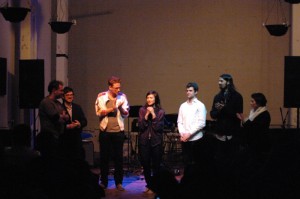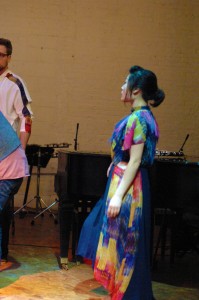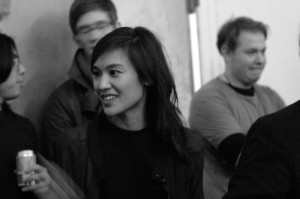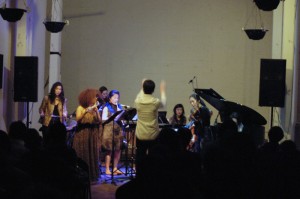
From left, Jonathan Cohen, Trevor Gureckis, Jay Wadley, Sugar Vendil, Ryan Manchester, Izzi Ramkissoon, Danielle Eva Schwob.
On Thursday I went to see a shmorgasborg of new works by young composers brought together by the curating of Sugar Vendil at The Nouveau Classical Project and the MATA Interval Series. The Nouveau Classical Project’s mission is to combine classical art music and fashion, but as I know almost nothing about fashion, I’ll put my music critic hat on and stand in the sound corner, while more knowledgeable folks can take on the visual & material side of the clothes.
If any of you remember the night of March 10th, 2011, you’ll know that in New York City it was miserably raining. So much so that the transportation in the city was a little slow. With that being said, I arrived just after Trevor Gureckis’ arrangement of Aphex Twin’s Cliffs began, and was held at the door by Issue Project Room staff. I feel inclined not to say anything about the piece as I feel that I should only review it if I weren’t listening through a door and a few seconds after it’s beginning. I also feel that there were clear aspects of the piece which I can describe and the effect of the piece was not lost on me for my tardiness.
Trevor’s program notes on the work describe how he’s set up the arrangement:
In this arrangement I’ve set it up be more improvisatory than a verbatim re-performance. The basic structure is the same but there are moments when the musicians improvise on individual cells pulled from the patterns.
Using light electronics to layer violin & flute “cells” with some echo effects, Mr. Gureckis replicates the quiet, somber, and quite frankly, post-minimal affect that Aphex Twin creates in the original track. The main difference is that the flute and violin in Gureckis’ piece take over for the voice and Koto effects that Aphex Twin use. Other than that, the arrangement is a fairly straight forward replica. The entire work is simple in its design, with the organ repeating the same harmonic progression and the instruments taking on the “cells”. Towards the end of the work (just as in Aphex Twin’s track) the organ drops out and the violin and flute improvise even as they make the now silent organ’s repeating harmony apparent.
The next work by Izzi Ramkissoon called The Asperity of Lace was written for Clarinet, Prepared Piano, and Live Electronics. There were two aspects to the live electronics in the work. One was the sound, with looping, pitch shifting, delay, time compression, expansion and the sampling of a pre-recorded prepared piano controlled by Mr. Ramkissoon from his laptop behind the audience. The other was a set of images and video programmed to track the clarinetist’s pitch. The entire work was very percussive (hey there prepared piano and electronics!) even degenerating into what I have decided to term a “grove-jam” (seriously it’s what I wrote down in my notes). In some of the segments of the work with fuller textures, it was very hard to pick out the individual instruments but eventually the looping and manipulation brought them out through repetition of musical fragments.
The third work of the evening was Mehr Licht by Danielle Schwob. I actually had the pleasure to hear this work a few weeks ago by different players at her organization Syzygy’s latest concert, “Plugged In”. Her program notes are fairly descriptive of the work in that it, “portray[s] a journey from obscurity towards the proverbial light at the end of the tunnel.” The work begins softly with a backing track of electronics and shortly there after, the percussionists use various instruments to imitate the sounds emanating from the computer. If I may cast aside the intentional fallacy for a moment and get a little programmatic in my description, the points of light represented by chimes, (some of the) electronics, and (what I assume to be) a mbira, can be seen but only through the murky water of the rest of the electronics track. Indeed, there are many instances evoking water to this listener, especially in the use of the wave drum (it might have been a sample of one though). As the light slowly becomes “clearer” the music converges and begins to form complete musical phrases. At the climax of the work, it drops the minimal & pointillist character and the violin takes on a full fledged melody. After the climax, a short denouement occurs and the music fades back into the minimal ideas, but maintains its new, more chromatic identity.
In the fourth slot was Ananta by Ryan Manchester. This work was far simpler than the other works on the program. Written for toy piano, electric cello and Tibetan singing bowl, the work relied heavily on the cellist and pianist exchanging fragments of lines or chords with interjections from the ringing of the Tibetan singing bowl. The work was responsorial in the way the cellist and pianist interacted. Overall the effect of the piece was meditative, and I didn’t even need to look at the program notes to see that Mr. Manchester was going for that.
Finally we had Things My Father Never Told Me by Jay Wadley. This work was probably the most traditionally minimal of the batch, with the clear influence of Steve Reich. On hearing the work, I thought Music for 18 Musicians, but I seem to be off because the composer claims Reich’s City Life was the main influence on the work. The most notable aspect of the work were some of the cool electronic effects that were used on the instruments. For example, the clarinet was manipulated at one point to sound like a fog horn, apparently by a “vocoder controlled by the breath of the clarinetist.” One thing I will note was that for such an array of sounds and textures, it was awfully short for a minimal work (in fairness, there was probably a time limit put on the only new commission of the concert).


